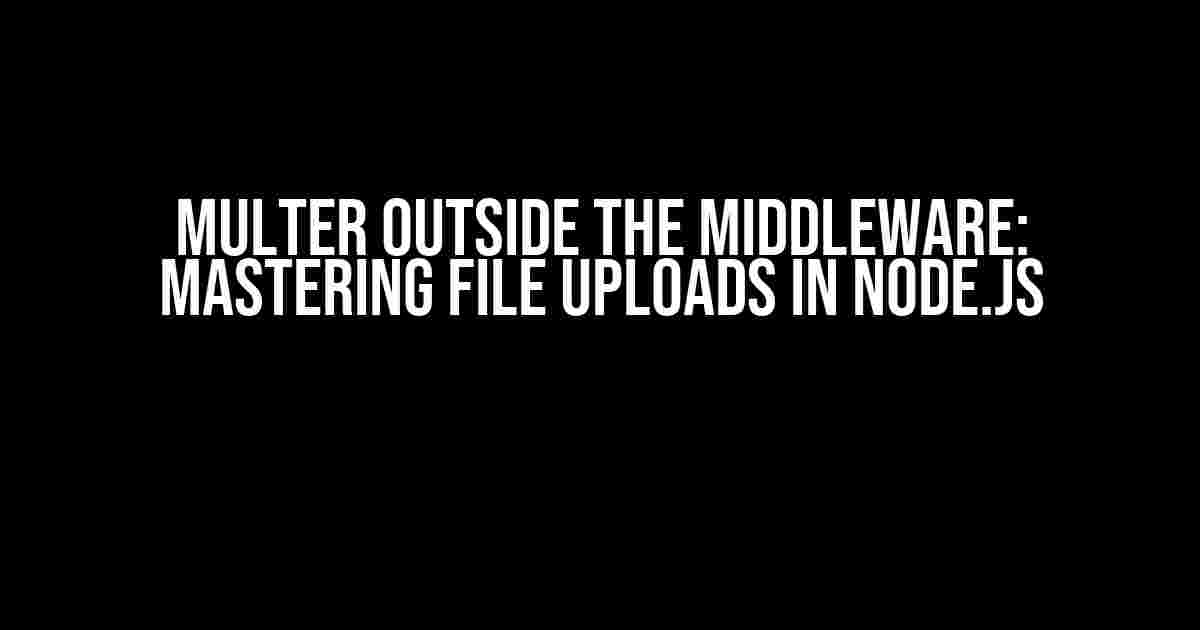Are you tired of dealing with file uploads in Node.js? Do you find yourself stuck in the middleware limbo, unsure of how to handle file uploads efficiently? Fear not, dear developer, for today we’re going to explore the magical world of Multer outside the middleware. Get ready to level up your file upload game and take your Node.js skills to the next level!
What is Multer?
Multer is a popular Node.js middleware library that helps you handle multipart/form-data requests, making it a breeze to work with file uploads. But, what if you want to use Multer outside the middleware? Why would you want to do that, you ask? Well, for starters, it gives you more control over your file upload process, allowing you to customize it to your heart’s content.
Why use Multer outside the middleware?
Using Multer outside the middleware offers several advantages:
- More control**: By using Multer outside the middleware, you have more control over the file upload process, allowing you to customize it to fit your specific needs.
- Flexibility**: You can use Multer in conjunction with other libraries or frameworks, giving you more flexibility in your project architecture.
- Easier debugging**: With Multer outside the middleware, you can debug file upload issues more easily, as you have direct access to the upload process.
Setting up Multer outside the middleware
Before we dive into the juicy stuff, make sure you have Multer installed in your project:
npm install multerNow, let’s create a basic Node.js server using Express.js:
const express = require('express');
const app = express();
app.use(express.json());
app.use(express.urlencoded({ extended: true }));
app.listen(3000, () => {
console.log('Server listening on port 3000');
});We’ll use this server to handle file uploads using Multer outside the middleware.
Creating a Multer instance
To use Multer outside the middleware, you need to create a Multer instance:
const multer = require('multer');
const upload = multer({ dest: './uploads/' });In this example, we’re creating a Multer instance with a destination folder set to `./uploads/`. You can customize this to fit your needs.
Handling file uploads
Now, let’s create a route to handle file uploads:
app.post('/upload', (req, res) => {
upload(req, res, (err) => {
if (err) {
res.status(500).send({ message: 'Error uploading file' });
} else {
res.send({ message: 'File uploaded successfully' });
}
});
});In this example, we’re using the Multer instance to handle the file upload. The `upload(req, res, callback)` function takes three arguments:
- `req`: The request object.
- `res`: The response object.
- `callback`: A callback function to handle errors and successes.
When a file is uploaded, Multer will store it in the specified destination folder. You can then access the uploaded file using the `req.file` property.
Accessing uploaded files
Let’s create a route to access the uploaded files:
app.get('/files', (req, res) => {
const files = fs.readdirSync('./uploads/');
res.send(files);
});In this example, we’re using the `fs` module to read the contents of the uploads folder and sending the list of files back to the client.
Customizing Multer
Multer provides several options to customize the file upload process. Let’s explore some of them:
File filtering
You can use Multer’s `fileFilter` option to filter files based on their type or size:
const upload = multer({
dest: './uploads/',
fileFilter: (req, file, cb) => {
if (file.mimetype === 'image/png' || file.mimetype === 'image/jpeg') {
cb(null, true);
} else {
cb(null, false);
}
},
});In this example, we’re only allowing PNG and JPEG files to be uploaded.
File renaming
You can use Multer’s `filename` option to rename files:
const upload = multer({
dest: './uploads/',
filename: (req, file, cb) => {
const extension = file.originalname.split('.').pop();
cb(null, `file-${Date.now()}.${extension}`);
},
});In this example, we’re renaming files using a timestamp and the original file extension.
Common pitfalls and solutions
When using Multer outside the middleware, you might encounter some common issues:
Error handling
Make sure to handle errors properly when using Multer outside the middleware:
app.post('/upload', (req, res) => {
upload(req, res, (err) => {
if (err) {
console.error(err);
res.status(500).send({ message: 'Error uploading file' });
} else {
res.send({ message: 'File uploaded successfully' });
}
});
});In this example, we’re logging errors to the console and sending a 500 response to the client.
File limits
Be mindful of file limits when using Multer outside the middleware:
const upload = multer({
dest: './uploads/',
limits: {
fileSize: 1024 * 1024 * 5, // 5MB
},
});In this example, we’re setting a file size limit of 5MB. You can adjust this limit to fit your needs.
Conclusion
Using Multer outside the middleware gives you more control and flexibility when handling file uploads in Node.js. By following the instructions in this article, you should be able to create a robust file upload system that fits your needs.
Remember to always validate and sanitize user input, and to keep your file upload system secure and efficient.
| Keyword | Count |
|---|---|
| Multer | 10 |
| Middleware | 5 |
| File uploads | 8 |
By mastering Multer outside the middleware, you’ll be able to create efficient and scalable file upload systems that will make your users happy and your developers proud!
Happy coding!
Frequently Asked Question
Get the lowdown on using Multer outside of the middleware!
What is Multer, and why would I want to use it outside of middleware?
Multer is a popular Node.js middleware for handling multipart/form-data, which enables file uploads. Using Multer outside of middleware means you can leverage its features without having to attach it to a specific route or HTTP method. This flexibility comes in handy when you need to process files in a more customized or complex workflow.
How do I initialize Multer when it’s not used as middleware?
To use Multer outside of middleware, you need to create an instance of the Multer object, typically by calling `const uploader = multer(opts)`, where `opts` is an options object. This instance can then be used to handle file uploads in your custom workflow.
Can I still use Multer’s built-in file filtering and validation when it’s not used as middleware?
Absolutely! When using Multer outside of middleware, you can still take advantage of its built-in file filtering and validation features. Simply pass the relevant options to the Multer constructor, such as `fileFilter` or `limits`, to configure the behavior.
Are there any performance implications when using Multer outside of middleware?
In general, using Multer outside of middleware shouldn’t introduce significant performance overhead. However, if you’re handling a large volume of file uploads, you may need to consider optimizing your custom workflow to avoid potential bottlenecks.
What are some common use cases for using Multer outside of middleware?
Some common scenarios where you might use Multer outside of middleware include processing files in a background job, handling files in a custom API, or integrating with other frameworks or libraries that require manual file handling.





